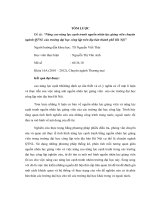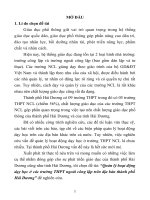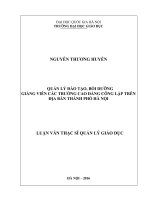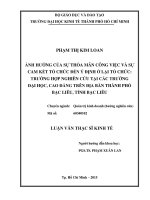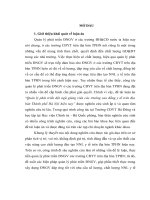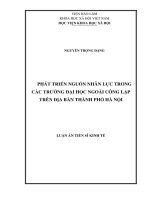Chất lượng giảng viên các trường đại học công lập trên địa bàn thành phố hà nội tt tiếng anh
Bạn đang xem bản rút gọn của tài liệu. Xem và tải ngay bản đầy đủ của tài liệu tại đây (160.02 KB, 29 trang )
MINISTRY OF
EDUCATION AND
TRAINING
MINISTRY OF LABOR,
INVALIDS AND SOCIAL
AFFAIRS
UNIVERSITY OF LABOR AND SOCIAL AFFAIRS
----------------
ĐINH THI TRAM
QUALITY OF LECTURERS OF
PUBLIC UNIVERSITIES IN HANOI CITY
Branch: Human resource Managerment
Code: 9340404
SUMMARY OF DOCTOR THESIS
HA NOI, 2020
THE THESIS HAS FINISED AT
UNIVERSITY OF LABOR AND SOCIAL AFFAIRS
Science instructor:
1. Assoc.Prof.Dr.TRAN XUAN CAU
2. Dr. VU HONG PHONG
Reviewer 1:
Prof.Dr. Nguyen Thanh Do
National Economics University
Reviewer 2:
Assoc.Prof.Dr. Mai Thanh Lan
Thuong Mai University
Reviewer 3:
Assoc.Prof.Dr. Bui Van Huyen
Ho Chi Minh national Academy of Politics and
Public Administration
The thesis is protected before the Council of doctoral
thesis
School level, University of Labor and Social Affairs.
Place: Room ………., Home ..... , University of Labor and
Social Affairs.
Số… - Street …………… - District ……………… - City
………………
Time: At …… hours …… month …… year 2020.
The thesis can be found at:
- National Library
- Library of University of Labor and Social Affairs
1
INTRODUCTION
1. The necessity of the study
Lecturers are a key determinant of quality in higher education and
are expected to be effective and committed. In Vietnam, the Ministry of
Education and Training has actively directed the implementation of the
activities of the Pedagogical Schools Development Program to improve the
capacity of the contingent of teachers and educational managers; build
pedagogical standards; criteria and process of selecting key pedagogical
teachers; promulgate and implement plans on training and retraining
teachers and educational administrators. The Ministry of Education and
Training has presided over and coordinated with the Ministry of Home
Affairs in issuing legal documents on criteria for titles and positions of
education officers; guide higher education institutions to formulate and
implement projects on job placement, transfer rankings for lecturers, assess
officials to review, screen and reduce staffing according to the guidance of
Central Executive Committee of the Party and the Government.
Recognizing the importance, seeing the existing limitations of the
quality of lecturers, PhD student have boldly conducted the study "Quality
of lecturers of public universities in Hanoi city" as my thesis topic.
2. Research purposes and tasks
PhD student set out the research objectives of the thesis as follows:
(1) Identify criteria for evaluating teacher quality and build a research
model for the factors affecting the quality of lecturers in public universities;
(2) Assess the situation of the quality of lecturers of public universities in
Hanoi and evaluate the impact of factors on the quality of lecturers of
public universities according to the research model proposed.
(3) Proposing some recommendations to improve the quality of lecturers of
public universities in Hanoi city in particular and the whole country in general.
For the specific research purposes mentioned above, the PhD
student raises the following research questions:
(1) What criteria are used to assess the quality of lecturers?
(2) What is the quality of lecturers of public universities in Hanoi city?
(3) What factors affect lecturer’s quality?
(4) What is the influence of factors on the quality of lecturers of public
universities in Hanoi city?
2
(5) What are the proposals to improve the quality of lecturers of public
universities in Hanoi city?
3. Research subject and scope
- Object of research: Quality of lecturers of public universities in Hanoi city
- Research scope:
+ Space: Public universities in Hanoi city (except for universities belonging
to the military and security)
+ Time: The data collected has time in the most recent 5 years: From 2015 2019.
4. Scientific and practical significance of the thesis
4.1. On the academic and theoretical side
- Using the set of criteria according to the Circular stipulating the
professional standards of pedagogical lecturer issued by the Ministry of
Education and Training in February 2018 in conjunction with Joint Circular No.
36/2014 / TTLT / BGDĐT - BNV committee issued on November 28, 2014 by
the Ministry of Education and Training and the Ministry of Home Affairs.
- Using quantitative research methods to evaluate the quality of
lecturers of public universities based on 5 criteria that have been identified
above.
- Building a research model on the factors affecting the quality of
lecturers of public universities including 06 independent variables. Through
surveyed data, the thesis has affirmed the positive relationship between the
independent and dependent variables.
4.2. On the practical side
Through quantitative survey results and analysis of survey results,
the thesis shows that:
- Actual quality of lecturers of public universities in Hanoi city today.
- Situation of the influencing factors and the degree of the influence on the
quality of lecturers of public universities in Hanoi city.
- Thereby, the dissertation has made a number of suggestions and
recommendations to improve the quality of lecturers of public universities
in Hanoi.
5. The structure of the thesis
In addition to the introduction, conclusion, list of references, appendices,
the thesis is structured into 5 chapters:
3
Chapter 1: Overview of research projects on lecturer’s quality
Chapter 2: Theoretical basis of the quality of lecturers of public universities
Chapter 3: Research methodology on teaching quality of public universities
in Hanoi city
Chapter 4: Research results on the quality of lecturers of public universities
in Hanoi city
Chapter 5: Discussion of research results and some recommendations to
improve the quality of lecturers of public universities in Hanoi city.
4
CHAPTER 1: OVERVIEW OF RESEARCH PROJECTS ON THE
QUALITY OF TEACHERS
1.1. Research criteria for evaluating lecturer’s quality
1.1.1. Researching lecturer’s quality according to KSA competency model
The quality of lecturers is mainly measured according to the KSA
competency model, with a clearer understanding of the quality and
personality of the lecturers. However, it can be seen that measuring teacher
quality under the KSA model only measures the inputs, that is, the input
quality of the lecturers but not specifically associated with the output
quality, ie efficiency in performing their work.
1.1.2. Researching on the quality of lecturers related to the quality of
teaching activities
For others, lecturer’s quality is about the quality of teaching activity.
For those who are concerned about efficiency, it involves improving student
achievement (Beijaard et al., 2004). Measuring teachers' quality is not only
measured by knowledge, skills, and attitudes, but also in performance.
1.2. Research the factors affecting the quality of lecturers
In essence, all the above studies have in common that the factors
affecting the quality of teachers include 3 main groups of facors: the lecturer
themself, the factors that belong to the school and the policy elements. for
lecturers. However, there is very little comprehensive research systematically
building a scale and measuring a specific scale on factors from the school that
affect the quality of lecturers of public universities. It can be said that these
studies are significant in both theoretical and practical terms and are the basis
for PhD student to apply and exploit research gaps to implement my thesis.
1.3. Research gaps
Through overview of the research projects, it can be seen that there
are some gaps in the aforementioned studies, specifically:
- In the context of public universities in Vietnam at present, there
are not many researches that clearly show the criteria for evaluating
lecturers’ quality.
- Up to now, no research project has built a model of factors
affecting the quality of lecturers of public universities in a specific,
systematic and verifying measurement as well as close correlation analysis.
Therefore, the PhD student exploited that research gap in the thesis
topic "Quality of lecturers of public universities in Hanoi city".
5
Conclusion of Chapter 1
In the first chapter, the PhD student has analyzed the overview of
research works on the quality of lecturers and draws the research gap
because in the context of public universities in Vietnam at present, there are
not many research projects clearly shows the criteria for assessing the
quality of lecturers and no research project has built a model of factors
affecting the quality of lecturers of public universities systemically and
scale test as well as closely correlated analysis.
6
CHAPTER 2: THEORETICAL BASIS OF QUALITY OF
LECTURERS OF PUBLIC UNIVERSITIES
2.1. Public universities in the higher education system
2.1.1. Some concepts
2.1.1.1. Higher education system
The university education system or otherwise called the higher
education network is the system of universities for postsecondary
education. The university system can be classified in many different ways;
depending on the purpose of the study to apply different criteria in the
classification of universities.
2.1.1.2. Public University
The concept, model and legal status of public universities vary in
the higher education system in each country. According to PhD student, a
public university is a school established and managed by the government.
The source of funding for public universities to operate depends on the
financial investment policy and the degree of socialization of resources for
higher education in each country.
2.1.2. The role of public universities
The establishment and operation of public universities demonstrates
the role of the state in higher education.
Public universities are the place to implement policies to invest in
higher education development of each country.
Public universities play a guiding role in the operation and
development of the national higher education system.
Public universities have the mission of training, providing high
quality human resources, scientific research and technology transfer to meet
the development needs of the country.
2.1.3. Characteristics of public universities
Public universities are an extremely important institution of society
and in the context of the global knowledge economy, the university's
responsibility is increasingly important to the development of the country. At
the same time, universities have very high autonomy in academic activities,
in the mode of management and training, etc. The awareness of the role,
mission and characteristics of the university is the foundation for planning
higher education policies, deciding on a management mechanism (including
7
financial management mechanism) suitable for universities to operate truly
quality, meeting the needs and expectations of the whole society.
2.2. Lecturers and lecturers’s quality of public universities
2.2.1. Some concepts
2.2.1.1. Lecturers
The concept of lecturers has many different approaches but they are
all consistent with the nature of the lecturers, that is, the person who is in
charge of teaching and educating in universities and colleges, in order to
impart scientific knowledge, capacity, practical skills for students and
building, forming a personality for learners, meeting the requirements of
social development …
2.2.1.2. Lecturer’s quality
The quality of lecturers is all of the attributes and characteristics
that reflect the level, competence, quality as well as the degree of
completion of the assigned tasks including teaching tasks, scientific
research tasks, community tasks or service activities.
2.2.2. Criteria for evaluating lecturers’ quality
The PhD student agreed to use the draft criteria set for a circular on
professional standards of pedagogical teachers issued by the Ministry of
Education and Training in February 2018 in combination with Joint
Circular No. 36/2014 / TTLT. -BGDĐT-BNV as a criterion for assessing the
quality of lecturers of public universities in my thesis topic.
2.3. The impact of lecturer’s quality on student achievement and the
quality of higher education
Many international studies underline the fact that good quality
schools are those that have good lecturers. Studies of the impact of
lecturers’ quality on student achievement and the quality of higher
education have further clarified the role of faculty members. Through the
above studies, policy makers and leaders of universities can set up a system
of solutions to improve the quality of higher education. And one of the most
practical and important solutions is to improve the quality of lecturers.
2.4. Factors affecting the quality of lecturers at public universities
2.4.1. Theoretical basis
Through the review of research projects, the PhD student found that
there are three groups of factors affecting the quality of lecturers, including:
factor groups from public universities; factor groups from State policies and
factor groups from lecturers themselves.
8
2.4.2. Some reference models on the factors affecting the quality of public
university lecturers
PhD student refer to research models of Michel Grangeat and Peter
Gray (2007), Ruth Naylor and Yusuf Sayed (2014), Gordon Musiige and
Peter Maassen (2015). Besides, the model of factors affecting the quality of
civil servants of Nguyen Manh Cuong (2017) is referred to the research
model. Research model on factors affecting the quality of civil servants in
state administrative agencies in the northern mountainous provinces of
Vietnam (studied in Dien Bien province) by Bui Van Minh (2017).
2.4.3. Research model of the thesis and research hypotheses
2.4.3.1. Research models
PhD student build an expected research model based on the research
of Bui Van Minh (2017), Nguyen Manh Cuong (2017) combining the
research of Ruth Naylor and Yusuf Sayed (2014):
Recruit
lecturers
Arrang and
use lecturers
Train and
foster lecturers
Quality of
lecturers
Current
policies for
lecturers
Remuneration
Facilities
Control variable:
- Sex
- Seniority
- Position
Diagram 2.1: Proposed research model of the thesis
2.4.3.2. Research hypotheses
With the arguments in section 2.3, based on the established research
model, PhD student has made the following research hypotheses:
Hypothesis H1: Recruit lecturers has a positive influence on the quality of
lecturers
9
Hypothesis H2: Arrange and use lecturers have a positive influence on the
quality of lecturers
Hypothesis H3: Train and foster lecturers has a positive influence on the
quality of lecturers
Hypothesis H4: Remuneration has a positive effect on the quality of
lecturers
Hypothesis H5: Facilities have a positive effect on faculty quality
Hypothesis H6: Current policies for lecturers have a positive influence on
the quality of lecturers
2.5. Quality of lecturers of some universities in the world and lessons
for Vietnam
By studying lecturers' recruiting standards as well as methods of
evaluating lecturers from countries around the world, PhD student draw
lessons for Vietnam as follows:
- Focusing on recruiting lecturers, improving input quality.
- Actively train and foster lecturers; designing advanced training
programs,
- Develop a reasonable and comprehensive set of teacher evaluation
standards on all aspects of teaching, research, and service activities.
- Pay attention to ethical issues and professional responsibilities of
lecturers.
Conclusion of chapter 2
In this chapter, the PhD student has given theoretical basis related
to public universities; criteria for evaluating the quality of public
universities. Thereby, the PhD student has also built a research model on
factors affecting the quality of lecturers of public universities including 6
basic factors: (1) Recruit lecturers; (2) Arrange and use lecturers; (3) Train
and foster of lecturers; (4) Remuneration; (5) Facilities; (6) Current policies
for lecturers. These will be the basic theoretical foundations for PhD student
to develop their thesis.
10
CHAPTER 3: RESEARCH METHODOLOGY ON QUALITY
OF LECTURERS OF PUBLIC UNIVERSITIES IN HANOI CITY
3.1. Research process
Researchers implement this topic based on research process:
B1. Find out the
overview
B2. Qualitative
research
B3. Building research models and scales
of variables
B4. Survey questionnaire design
B5. Trial survey
B6. Official survey
B7. Data analysis
B8. Comments and propose solutions
Diagram 3.1. The research process of the thesis
Source: NCS built
3.2. Data sources
PhD student use 2 main data sources:
11
- Secondary data: PhD student gathered from the statistics of the Ministry
of Education and Training, Hanoi Statistical Office, reports of public
universities in Hanoi city and related research projects.
- Primary data: PhD student gathered from interviews, building
questionnaires, conducting surveys of lecturers of public universities in
Hanoi.
3.3. Research Methods
3.3.1. Qualitative research
The purpose of qualitative research is for the PhD student to more
accurately identify the factors affecting the quality of lecturers. PhD student
researched and listed the factors affecting the quality of lecturers according
to the previous researches. After that, the PhD student hold on seminars to
consult with experts in the field of energy management as well as
management and leadership officers at public universities in Hanoi to select
factors. It is expected to have the most impact on the quality of current
lecturers.
3.3.2. Quantitative research
3.3.2.1. Process of forming a questionnaire
(1) Define the theoretical concept of variables and how to measure variables
in the theoretical model based on previous studies.
(2) Develop a preliminary questionnaire based on previous studies.
(3) Send questionnaires to 10 experts and lecturers working at public
universities in Hanoi to evaluate and comment on the scales given by the
PhD student. The purpose is to ensure the completeness of the scale,
suitability, clarity, comprehension, convenience and comfort when
responding. The results of the experts' comments were used to review and
finalize the observed variables of each scale and complete the official
questionnaire.
(4) Preliminary quantitative research: through the survey of 50 lecturers
currently working at public universities in Hanoi. The purpose of
preliminary quantitative research is to eliminate non-conforming and
unreliable scales before conducting official surveys.
(5) Form a formal questionnaire for a large-scale survey with 400 lecturers
including 1 dependent variable and 6 independent variables as defined in
the research model with 53 questions.
3.3.2.2. Development scale
12
Table 3.1. Measurement scale of lecturer quality
Encod
e
CLGV
Variable name
Quality
lecurers
of
TD
Recruit lecturers
BT
DN
Arrange and use
lecturers
Train and foster
lecturers
Remuneration
VC
Facilities
CS
Current policies
for lecturers
DT
Origin of the scale
Apply the criteria set of the Ministry of Education and
Training (2018) and Joint Circular of the Ministry of
Education and Training and the Ministry of Home Affairs
(2014)
Application of adjusted scales of Naylor and Yusuf Sayed
(2014) and Tran Quang Huy (2017)
Application of adjusted scale of Naylor and Yusuf Sayed
(2014)
Application of adjusted scales of Amin et al (2014)
Application of adjusted scales of Naylor and Yusuf Sayed
(2014), Amin et al (2014) and Nguyen Thuy Dung (2015)
Author [based on recommendations of Nguyen Manh
Cuong (2017) and Bui Van Minh (2017)]
Application of adjusted scales of Naylor and Yusuf Sayed
(2014) [There is a combination of scales of Nguyen Manh
Cuong (2017) and Bui Van Minh (2017)]
Source: synthesis of author
Control variable:
Some factors reflecting the characteristics of the research object
used by the PhD student included in his thesis include gender, seniority,
position ...
3.3.2.3. Designing research samples
The country currently has 193 public universities, of which Hanoi
has 69, accounting for 35.75%. The thesis of PhD student has the research
scope of public universities in Hanoi, except for universities belonging to
the military sector, People's Armed Forces.... To achieve the appropriate
sample size, the PhD student issued a number of 400 votes, ensuring the
principle of sample redundancy in the study.
3.3.2.4. Data analysis
- Analyzing descriptive statistics
- Testing the scale with Cronbach’s Alpha
- Explore factor analysis
- Multivariate regression results
- Testing statistical hypotheses
13
Conclusion of chapter 3
In chapter 3, the PhD student presented clearly the research process
and methods on the quality of lecturers and the factors affecting the quality
of lecturers.
In the context of the research is public universities in Hanoi, PhD
student have conducted qualitative research and quantitative research to test
the impact of factors including recruit lecturers; arrange and use lecturers;
train and foster lecturers; remuneration; facilities and current policies for
lecturers to the quality of lecturers. The study was carried out with a
number of 400 lecturers, enough to ensure the reliability and
representativeness of the sample size.
CHAPTER 4: RESEARCH RESULTS ON QUALITY OF
LECTURERS OF PUBLIC UNIVERSITIES IN HANOI CITY
4.1. Some characteristics of public universities in Hanoi city
4.1.1. Number of public universities in Hanoi city
According to the official data released by the Ministry of Education
and Training in April 2018, the country has 242 universities, of which 193
public schools, accounting for 80% and 49 non-public schools, of which
Hanoi has 69 public schools accounted for 35.75%. It can be seen that
Hanoi is a city with a large concentration of public universities.
4.1.2. Training size
Compiled with data from the Ministry of Education and Training
(2016), the total number of students from universities in Hanoi in the
academic year 2015-2016 was more than 626,258 students. In particular,
students of public schools accounted for the majority with 89.42%; regular
training students account for 71.01%. By the school year 2016-2017, the
total number of students in Hanoi increased by 9.24% compared to the same
period in 2015-2016. In particular, the number of students of public schools
accounted for 87.53%; students of formal training account for 73.94%.
School year 2017 - 2018, the total number of students in Hanoi is 654,440.
Thus, this school year decreased by 4.33% compared to the previous school
year. Of which, public students accounted for 86.75%; regular students
make up 78.18%.
4.1.3. Training fields
14
The size of public universities in Hanoi has increased significantly.
Thanks to the rapid increase in the scale of education and training, the
number of graduates has increased rapidly, adding a workforce of qualified
and increasingly qualified workers, meeting a significant part of the demand
of human resources for economic development in a market economy,
openness and integration. However, many schools that open the training
industry still rely on their inherent capacity and experience, leading to the
lack of social industries. These are the reasons why the industry structure is
unreasonable and the quality of training is limited, failing to meet the needs
of the country's socio-economic development.
4.2. Actual quality of lecturers of public universities in Hanoi city
4.2.1. The size of lecturers of public universities in Hanoi city
According to aggregated data, the number of full-time lecturers of
public universities in Hanoi has been on an upward trend in recent years.
Specifically, in 2015 - 2016, the number of organic lecturers was 23,775
lecturers. By 2016 - 2017, the number of full-time lecturers was 23,253
lecturers, increasing to 478 lecturers, equivalent to 2.1% compared to 20152016. In 2017-2018, the number of lecturer members was 23,832 lecturers,
an increase of 579 lecturers equivalent to 2.5%. Thus, the number of
organic lecturers at public universities in Hanoi is increasing.
4.2.2. The structure of lecturers of public universities in Hanoi city
4.2.2.1. Lecturer structure by title and qualification
According to the Ministry of Education and Training's statistics, in
2016-2017, at the public universities in Hanoi, the number of lecturers with
doctoral degrees is 5,206 and masters are 13,134. In 2016, the State
Professor Title Council recognized 140 professors and 1302 associate
professors. The number of lecturers with university degrees is 3119. In
2017-2018, the number and qualifications of lecturers of public universities
in Hanoi also increased significantly. Compared to the academic year 20162017, the number of professors was 198 people (up 41.4%); Associate
professor was 1423 people (up 9.3%); The number of lecturers with a PhD
degree is 6376 (an increase of 22.5%); The number of lecturers with a
Master's degree is 13446 (an increase of 2.4%). Although increasing in
terms of qualifications, the growth rate is not commensurate with the needs
and has not met the needs and requirements of public higher education, has
not met the requirements of the country and international integration. This
is the general situation of public universities in Vietnam.
4.2.2.2. Lecturer structure by job title
15
The majority of lecturers at public universities in Hanoi have the
professional title of Lecturer (Class III). Specifically in the 2015-2016
academic year, the number of third-class lecturers is 13712, accounting for
60.2% of the total number of full-time lecturers. In 2016 - 2017, this figure
was 13910 people, 59.8% and in 2017-2018 was 14005 people, accounting
for 58.8%. The fluctuation in job title category III tends to decrease but at a
slow pace.
The number of lecturers holding the title of second-class career has
tended to increase in recent years, but the difference between years is not
much.
4.2.2.3. Lecturer structure by level of political theory
The current level of political theory of lecturers of public
universities is mainly intermediate level of political theory with 13822
people, accounting for 58% of the total number of faculty members of the
universities. The number of lecturers with a primary level of political theory
is 5730, accounting for 24% and the final number of lecturers with a high
level of political theory is 4290 people, accounting for 18%. This structure
is relatively reasonable.
4.2.2.4. Lecturer structure by age
Statistics from the Ministry of Education and Training (2018) show
that the age structure of lecturers of public universities in Hanoi is relatively
reasonable today. The number of lecturers aged from 31 to under 40 and
from 40 to under 50 years old is the majority with 33% and 37%. The
number of lecturers under 31 and over 50 accounted for less than the
proportion of 11% and 19%.
This structure has created a balance and rationality for lecturers of
public universities, contributing to higher and higher results in teaching and
research.
4.2.2.5. Lecturer structure by gender
In the school year 2017-2018, with the total number of organic
lecturers of public universities in Hanoi city is 20,832 people, female
lecturers are 13,584 people (accounting for 57%) and male lecturers are
10,248 people ( accounting for 43%). The gender structure of lecturers in
public universities in Hanoi also does not have too much gender difference.
4.2.2.6. Foreign language, computing skills of lecturers
As for lecturers' IT level, there are 21925 lecturers who have IT
certificates at the level of basic information technology skill use (except
16
lecturers teaching IT majors and other relevant sectors) accounted for 92%
of the total number of faculty members of the school.
4.2.2.7. Teaching capacity
In recent years, lecturers of universities in general and public
universities in Hanoi in particular have actively renovated teaching
methods, enhanced application of scientific and technological achievements
into teaching. Innovating teaching methods of teachers originates from
learning requirements of learners. In addition, the teaching staff is always
volatile and supplemented from different sources each year so the
qualifications and competencies are uneven, even some people have not
been trained and fostered in professional practice, leading to low teaching
quality.
4.2.2.8. The level of participating in scientific research activities
In Hanoi City, Ha Noi National University has the most
international articles and publications with 959 articles; followed by Hanoi
University of Science and Technology with 743 articles; Third place is
Hanoi National University of Education with 237 articles. As PhD student
analyzed above, Hanoi has 69 public universities, however, as of June 2018
only 19 schools have published internationally over 20 articles (27.5%);
There are even many schools with no or negligible ones.
It is interesting to note that despite the large number of lecturers,
the number of scientific research projects is limited, many lecturers do not
participate in scientific research, many lecturers do not have articles
published in domestic and foreign scientific journals. The number of
schools with internationally recognized articles (with ISI / SCOPUS article)
is very modest. There are many university lecturers with doctorates or many
years of teaching experience, but there are not many suitable research
projects or they have not done any works. Many scientific research projects
have been conducted with low quality.
4.2.3. Evaluate lecturer’s quality according to quantitative survey results
- About professional qualities
Assessing the professional quality, most lecturers highly
appreciated the "political quality" with the average score of 3.0067. Next is
the "moral quality" with an average score of 2.9060; Opinion about
"lifestyle, professional style” is lower with 2.8055. This means that at
present, the fight and prevention of violations of laws and professional
regulations of lecturers is not high. And this is also a practical weakness
17
that occurs today, when the spirit of criticism and self-criticism of officials
and lecturers has not been taken seriously.
- About professional competence
Among the observed variables given by the PhD student, the
"qualification" is best evaluated with an average of 4.020. The two lowest
lecturers' comments were "foreign language ability" and "IT applicability"
with scores of 2.5471 and 2.5318 respectively.
- About scientific research capacity
The comment "number of publications, articles published in
prestigious magazines" is rated with the highest score of 3.7852. The most
under-rated comments were "Number of topics and projects at all levels"
and "Writing articles published in domestic and foreign scientific journals;
writing journals, scientific reports, presentations at scientific conferences
and seminars”with an average score of 3.3201.
- About building a democratic education environment
With the observations given by the PhD student, the average
evaluation score was above 3.5 points. Specifically, the highest rated
opinion is "Creating a friendly study and research environment" with an
average score of 3.8953. Next is the opinion on "Building and
implementing grassroots democracy" with 3.7681 points. The lowest rating
was the opinion on "Level of comments on the development of policies for
the school" with 3.5569 points.
- About capacity to develop social relations
Regarding the capacity of developing social relations, the lecturers
all rated the highest score of 3.8924 and the lowest score of 3.1089. The
most valued opinion of the lecturers is building a "relationship with
colleagues" with an average of 3.8924. And the lowest rating is the
"relationship with business" opinion with a score of 3.1089. Thus, it can be
seen that most lecturers have assessed the capacity of developing internal
relations of the school quite well but building and developing relationships
with external units such as businesses or institutions. Other training
facilities are somewhat lower.
4.3. Quantitative research results on the factors affecting the quality of
lecturers of public universities in Hanoi city
4.3.1. Descriptive statistics research sample
In order to ensure the achievement of 265 votes, the PhD student
issued 400 votes. The result was 375 valid votes and 25 invalid votes. Of
18
which, 103 votes passed online surveys (accounting for 27.5%) and 272
votes sent directly to lecturers (accounting for 72.5%). Subjects surveyed
by PhD student structure by gender, seniority, career title, position.
4.3.2. Statistics describe the variables in the research model
4.3.2.1. Recruit lecturers
Through the survey results, it can be seen that the recruitment
activities of the school are rated by lecturers as being average. The opinion
of "Representatives of units that need additional labor (Faculty /
Department) invited to participate in the recruitment process" is rated
highest with an average score of 3.6854. The two opinions that the faculty
rated the most are "the school pays much attention to recruiting organic
faculty for the school" and "During the selection process, the school always
upholds its professional and research competencies. members” with a score
of 2.7567 and 2.7590 respectively.
4.3.2.2. Arrange and use lecturers
Surveying the evaluation of lecturers on the arrangement and use of
lecturers, the opinion "When realizing the imbalance of personnel, the
university conducts the transfer of lecturers between departments and
subjects" is rated the highest with an average score of 3.6135 points. The
opinion that the instructor rated the least is "The assignment and staffing of
the school is to ensure fairness for lecturers".
4.3.2.3. Train and foster lecturers
The given comments are evaluated over 3.1 points. The highest rated
opinion is that "The school has regulations to encourage lecturers to improve
their own learning" with 3.8505 points. This shows that the current schools
have focused more on training and retraining of lecturers. However, the level of
interest is not adequate and has not brought about real effectiveness.
4.3.2.4. Remuneration
In terms of remuneration, the opinion that "The school's
compensation rate is set based on the capacity and ability of officials and
lecturers" with 3.5784 points. The opinion "The school's remuneration
system is attractive to faculty and the school's Compensation is on par with
other public universities" as the lowest rated lecturer below 3.0; namely
2.9672 and 2.9554.
4.3.2.5. Facilities
With the school's facilities variable, the instructors have different
assessments between different opinions. The highest rated opinion of the
19
lecturers is "The level of responsiveness in terms of operating cost of the
unit is reasonable". The opinion that lecturers rated the lowest is
"equipment, facilities for effective teaching and researching process" with
2.859 points.
4.3.2.6. Current policies for lecturers
Among the policies proposed by the PhD student, the lecturer
highly rated the "Policy of changing the career system to the position
system" with 3.5488 points. Lecturers underestimate the "salary policy for
lecturers" with 2.8714.
4.3.3. Verify the reliability of the scales
4.3.3.1. Testing Cronbach’s Alpha coefficients
The analytical results show that the cronbach’s alpha coefficient of
the variables in the research model is greater than 0.8. The correlation
coefficient - the total variable of the component variables is greater than
0.3. The cronbach’s alpha coefficients for these component variables are all
0.6. Therefore, the component variables of the variables are highly reliable,
so they will be used for analysis in the next steps.
4.3.3.2. Explore factor analysis (EFA)
After analyzing the first rotation matrix of EFA, training and
retraining of lecturers with DT6 observations were excluded from the
research model, the PhD student conducted the second EFA and showed
more satisfactory results. Specifically, the Bartetts test results show that the
variables in the population are correlated with each other (Sig = 0.000) and
the KMO coefficient of 0.865 proves the suitability of EFA. The
Eigenvalues value is 1.104, the observed variables are grouped into 6
factors with a total variance extracted by 65,176% reflecting these 6 factors,
explaining 65,176% of the variability of the surveyed variables. The
analysis results of the rotation factor EFA show that all observed variables
have Factor Loading> 0.5 with satisfactory value, and are divided into 6
groups of factors.
4.3.4. Testing hypotheses
4.3.4.1. Analyze the correlation and multi-collinearity between the factors
The quality of lecturers is correlated with teacher recruitment;
arranging and using lecturers; train and foster lecturers; remuneration;
Facilities; The current policy for lecturers in turn is 0.541; 0.532, 0.101;
0.515; 0.468 and 0.391. The significance levels of the correlation
coefficient test are less than 0.05, so it can be concluded that the variables
20
are correlated with each other and statistically significant. However, the
correlation coefficient between many variables is also quite large> 0.3, so
when analyzing the correlation, it is necessary to pay attention to the
autocorrelation phenomenon between independent variables.
4.3.4.2. Analysis of factors affecting teacher quality by regression model
On the basis of factors tested by Cronbach’s alpha coefficient and
EFA exploratory factor analysis method, PhD student has adjusted the
research model. Accordingly, PhD student has regressed the model of
factors affecting the quality of lecturers of public universities in Hanoi city.
The corrected correlation coefficient of this model is equal to 0.632,
indicating that the variables in this model account for 63.2%. Durbin
Watson's number was 1,769. This value is appropriate because it ranges
from 1 to 3. Thus, the multiple regression model satisfies the conditions of
evaluating and testing the suitability for drawing research results.
Therefore, we have a sample regression model:
CLGV = 0.70 + 0.332TD + 0.275BT + 0.226DT + 0.318DN + 0.213VC +
0.196CS
According to the regression analysis model, all 6 factors are
positively correlated with the quality of lecturers. The larger the regression
coefficients of factors are, the stronger impact on teacher quality is.
Through the regression analysis, the Sig coefficients are all less than 0.05,
the regression coefficients are positive. That means the hypotheses that the
PhD student initially set out are accepted.
4.3.5. Quality of lecturers of public universities in Hanoi city according to
the characteristics of the survey subjects
For gender, the results confirm that there is no difference in the
quality of lecturers by gender. For seniority and position, the test results
show that there are differences in the quality of lecturers.
Conclusion of chapter 4
In chapter 4, PhD students presented some characteristics of the size and
structure of public universities in Hanoi, thereby evaluating the general
overview of the context of the research in my thesis. Using quantitative
research results, the PhD student analyzed the research results as a basis for
assessing the quality of lecturers, and also strengthened the analysis results
from the secondary data above. In addition, the PhD student evaluated the
impact of these factors on the quality of lecturers of public universities.
21
CHAPTER 5: DISCUSSION OF RESEARCH RESULTS AND SOME
RECOMMENDATIONS TO IMPROVE THE QUALITY OF
LECTURERS OF PUBLIC UNIVERSITIES IN HANOI CITY
5.1. Discuss the research results
5.1.1. Regarding the quality of lecturers of public universities in Hanoi
city
+ Points achieved
Basically, the professional qualifications of lecturers are constantly
improved to meet the requirements of international integration.
Scientific research is more active by lecturers, not only within the country
but also internationally.
The level of political reasoning has been increasingly improved, built on
morality, and led a healthy lifestyle
Always focus on improving foreign language skills in teaching and
communication, information technology application skills in teaching and
research.
+ Some limitations
With the standard of professional quality, many lecturers selfassessed and thought that the lifestyle and working style of the lecturers
were not high. This criterion is rated lowest among the 3 criteria of
professional quality standards.
For professional competence, according to preliminary assessment,
this standard is increasingly improved by lecturers. The standard of
scientific research competency is one of the important criteria for assessing
the quality of lecturers. However, the implementation of scientific research
for many lecturers is not really serious, just a coping nature. The quality of
scientific research products has not been highly appreciated. The works
published internationally as journals with ISI, Scopus... are quite small
compared to the total number of lecturers of public universities.
Standards on building a democratic educational environment are
those that demonstrate equality, fairness and democracy in education among
lecturers and students, non-violence and social evils. However, there still
exist a few schools which are still in a state of conservative, obstinate,
disrespectful and listening cadres; teachers and staff are passive, defensive,
coping, lack of confidence in the collective and leadership, lack of capacity
and experience to master in the unit ...

